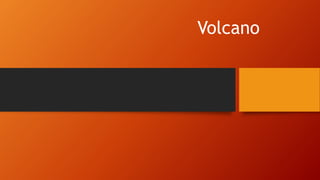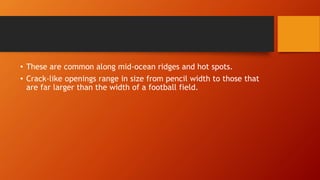Volcanic products
- 1. Volcano
- 2. The word volcano, from the Roman god of fire, has two meanings: 1) The opening in the ground out of which hot molten rock (lava or magma) and/or volcanic gas issues from the earth's interior onto the surface. 2) The hill or mountain built up around such an opening by the accumulation of cooled magma.
- 3. Volcanic openings may be: 1) Circular- Lava that is poured or thrown out of circular pipes (vents) forms tall, steep-sided mountains (like Mt. Agua). These are common above subduction zones. Circular openings vary in size from manhole covers to those that are larger than the LBS Ground of IIT Roorkee.
- 4. ? 2) Long, skinny, snakelike cracks called rifts or fissures. Lava that is poured or thrown out of long, skinny cracks (rifts) forms plateus (like the Columbia or Snake River) or low angled hills or mountains (like Mona Loa).
- 5. ? These are common along mid-ocean ridges and hot spots. ? Crack-like openings range in size from pencil width to those that are far larger than the width of a football field.
- 6. Overall there are three major kinds of lava: ? Mafic- called basalt. Composed of lots of iron, magnesium, and calcium along with aluminum, silica and oxygen to make minerals like olivine, pyroxene, and calcic plagioclase). ? Felsic- called dacite or rhyolite. Composed of lots of potassium, sodium, aluminum, silica, and oxygen to form such minerals as quartz, potassium feldspar, sodic-rich plagioclase. ? Mixed or intermediate- called andesite. This lava is in between the other two, containing some iron and magnesium-rich minerals as well as sodium and potassium-rich minerals.
- 7. BASALTIC LAVA ? Basaltic lava flows erupt primarily from shield volcanoes, fissure systems, scoria cones, and spatter cones. These fluid lava flows can be subdivided into two end-member structural types, based primarily on the nature of lava flow surfaces:
- 8. ? Pahoehoe Lava -- Surfaces are smooth, billowy, or ropy. It is typically the first to erupt from a vent.
- 9. ? As the smooth lava surface cools to turns to a dark gray color and becomes less fluid and more viscous, behaving more like a plastic substance than a truly liquid substance. ? As lava continues to flow underneath this plastic skin, the surface can bunch up or wrinkle into a form that resembles coiled rope. Such a surface is called ropy pahoehoe. ? Similarly solidified basalt flows can also display shelly surfaces called Shelly pahoehoe.
- 10. A'a lava -- Surfaces are fragmented, rough, and spiny, with a "cindery" appearance
- 11. ? The a'a flows are advancing over older pahoehoe surfaces. ? These are more viscous, and typically thicker, than pahoehoe lavas. ? Pahoehoe is often converted to a'a as lava advances downslope, away from the volcano. ? caused by either an increase in flow viscosity, or an increase in the rate of shear.
- 13. Andestic Lava ? andesite generally produces blocky lava ? the surface contains smooth-sided, angular fragments (blocks)
- 14. FELSIC LAVA DACITIC TO RHYOLITIC LAVA ? With increasing silica (SiO2) content and polymerization, the viscosities of these felsic lavas increases.
- 15. Unusual Lava Type ? STRONGLY ALKALINE LAVAS-alkali content, reflected in their weight percent of Na2O + K2O
- 16. They are typically found in (1) continental or oceanic intraplate settings, where there is often a lack of significant tectonic control, (2) continental rift zones, and (3) the back-arc setting of subduction zones.
- 17. ? CARBONATITES - They are defined, when crystalline, by having more than 50% carbonate (CO3-bearing) minerals, and typically they are composed of less than 10% SiO2.
- 18. ? KOMATIITES - komatiites are ultramafic volcanic rocks, having very low silica contents (~40-45%) and very high MgO contents (~18%). ? A spectauclar identifying trait of komatiites is their spinifex texture


















